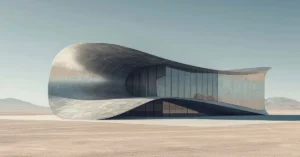Unlocking Sustainable Design through Biomimicry in Modern Architecture
In the world of architecture, innovation often stems from looking to nature for inspiration. Biomimicry, a fascinating concept, draws upon the brilliance of natural designs and processes to create sustainable, efficient, and aesthetically pleasing architectural solutions. This article delves into the realm of biomimicry in architecture, highlighting its principles, benefits, and practical applications.

Understanding Biomimicry in Architecture
Biomimicry, derived from “bio” (life) and “mimesis” (imitate), involves emulating natural patterns, forms, and strategies in architectural design. By observing how nature has perfected its structures over millions of years, architects can draw inspiration to solve complex design challenges. This approach promotes harmony between human creations and the environment, resulting in designs that are not only functional but also ecologically sensitive.
Principles of Biomimicry in Architecture
- Form and Function:
Nature’s designs are often the epitome of form meeting function. From the aerodynamic efficiency of bird wings to the self-cooling structures of termite mounds, biomimicry encourages architects to prioritize both aesthetics and functionality. - Sustainability:
Nature operates in closed loops, with waste from one process becoming a resource for another. Architects can mimic this circularity by designing buildings that generate energy, capture rainwater, and utilize recyclable materials. - Adaptation:
Natural organisms adapt to their surroundings to thrive. Similarly, buildings can be designed to respond to changing environmental conditions, optimizing energy use and occupant comfort. - Local Context:
Just as species adapt uniquely to their ecosystems, biomimetic architecture should consider the local climate, geography, and culture to create designs deeply rooted in their surroundings.
Benefits of Biomimicry in Architecture
- Environmental Sustainability:
Biomimetic designs often minimize resource consumption and reduce the carbon footprint of buildings, contributing to a more sustainable built environment. - Energy Efficiency:
Learning from nature’s energy-efficient strategies, such as using natural ventilation and passive solar heating, can lead to buildings that require less energy for heating, cooling, and lighting. - Resilience:
Natural systems are inherently resilient. By incorporating this resilience into architectural designs, we can create structures better equipped to withstand natural disasters and changing climate conditions. - Innovation:
Biomimicry encourages out-of-the-box thinking, pushing architects to explore unconventional solutions that merge biology and technology.
Practical Applications of Biomimicry in Architecture
- Structural Design:
The study of bones and trees has inspired innovative structural systems that use less material while maintaining strength and stability. - Water Management:
Mimicking the water-absorption abilities of natural surfaces, architects can create buildings with efficient rainwater harvesting and management systems. - Cooling Systems:
Termite mounds’ ventilation principles have led to the development of passive cooling techniques that reduce the need for energy-intensive air conditioning. - Solar Design:
Sunflowers tracking the sun’s movement have inspired solar panels that follow the sun for maximum energy capture. - Facade Innovation:
Adaptive facades, inspired by the ability of pinecones to open and close in response to humidity, can regulate interior temperature and lighting.
Conclusion
Biomimicry in architecture bridges the gap between human design and the brilliance of nature. By imitating nature’s time-tested solutions, architects can create buildings that are not only visually stunning but also ecologically responsible and resilient. As the world seeks sustainable alternatives to traditional design practices, biomimicry stands out as a beacon of inspiration, offering a harmonious path towards a greener and more innovative future in architecture.
In the ever-evolving realm of architecture, the integration of biomimicry stands as a beacon of promise and innovation. By tapping into nature’s vast repository of designs and processes, architects can embark on a journey towards a harmonious and sustainable future. The fusion of human ingenuity with the brilliance of the natural world leads to structures that not only captivate the eye but also nurture the environment.
As the architectural landscape continues to shift towards eco-consciousness and resilience, biomimicry emerges as a guiding principle, offering a profound shift in the way we conceive, design, and inhabit our built spaces. Embracing nature’s wisdom, we can construct not only buildings but also narratives of harmony, creativity, and responsible coexistence with the planet we call home.
For more SketchUp tutorials you can check out https://www.sketchupguru.com/blog/
You can also check more tutorial videos for sketchup on our YouTube Channel,
https://www.youtube.com/c/SketchupGuru
To know about the Top Online 3D Rendering Courses for 2022 click,













